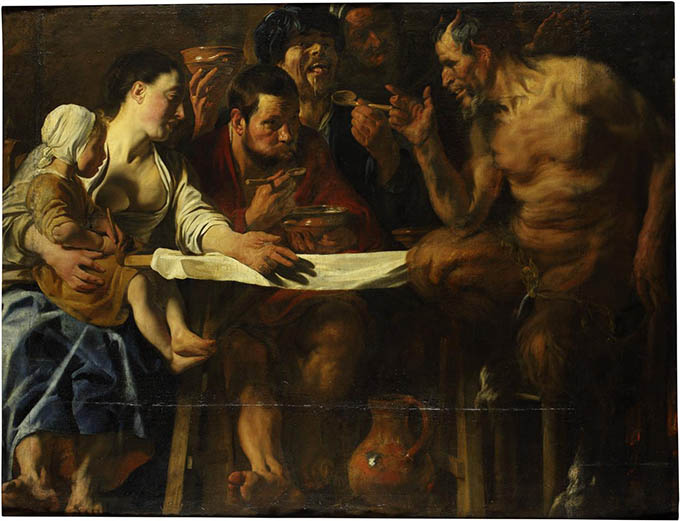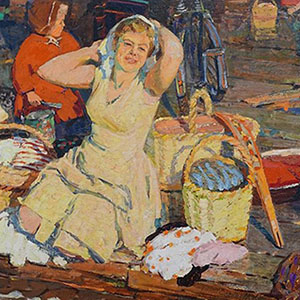An exhibition of the Flemish artist Jacob Jordaens opens at the Pushkin Museum on September 17

A large-scale exhibition “Russian Jordanians”, which will present all the most significant works of the Flemish artist Jacob Jordaens in museums in Russia, will open at the Pushkin Museum of Fine Arts on September 17, the institution’s press service reports.
Jordaens is one of the prominent representatives of the Flemish Baroque. His works appeared in Russia in the second half of the 18th century, when Catherine II bought up his paintings for the Hermitage founded in 1764. Following Catherine, the Russian aristocracy began to collect paintings by Flemish masters of the Golden Age, and, in particular, the works of Jacob Jordaens.
The exhibition will show for the first time almost all the works of the master, which are in the collections of Russian museums: the Pushkin Museum im. Alexander S. Pushkin, the State Hermitage Museum, the Yekaterinburg Museum of Fine Arts, the Nizhny Novgorod State Art Museum and the Perm State Art Gallery. One of the artist's works is provided by the Holy Trinity Alexander Nevsky Lavra (St. Petersburg). The exhibition has 18 paintings and 31 drawings reflecting the main stages of the artist’s creative biography, the variety of types and genres in which he worked, and the evolution of his style.
Jacob (Jacques) Jordaens (1593–1678) is one of the most significant painters of the Flemish school along with Rubens and Van Dyck. He worked in almost all genres: he created paintings on religious, mythological, historical subjects, painted portraits and still lifes, preferring everyday compositions with burlesque elements. At a young age, Jordaens began to study painting with the once popular Antwerp historical painter and portrait painter Adam van Noort, who is now also known as one of Rubens’s teachers. Jordans' works are distinguished by the baroque expressiveness of plastic forms, glorifying the beauty and abundance of the material world, the solemn sound of color and ingenuity in the construction of the composition. He equalized in his works elevated and earthly themes, which corresponded to the general life-affirming orientation of Flemish art. An important stage in the creative formation of the artist was such an international movement as caravagism, but Jordaens remained independent in the deeply individual painting techniques and themes of his art.
The name of the exhibition “Russian Jordanians” emphasizes that the exposition combines the artist’s works located in Russian collections. Most of them appeared in Russia in the second half of the 18th century and come from the best European collections of the time: British (Robert Walpole), French (Pierre Croz), German (Ernest Gotskovsky and Count Heinrich von Bruhl). Some of the paintings were bought by Empress Catherine II for the Hermitage, founded in 1764. It was Catherine II who acquired from a Berlin collection the monumental work of Jordaens “Mourning of Christ”, and then presented it to the Alexander Nevsky Lavra in St. Petersburg. Following the empress, the Russian aristocracy began to collect paintings by Flemish masters of the golden age, and, in particular, the works of Jordaens.
Russian museums have an interesting, albeit numerically small, collection of Jordaens painting, which allows showing the best examples of his art in almost all genres. Chronologically, these works relate to the period from the moment the artist received the title of free master of the guild of St. Luke in Antwerp until the mid 1660s. An important part of the exhibition was four paintings provided by Russian regional museums - “Christ and the Samaritan Woman” (Nizhny Novgorod State Museum of Art), “Meleager and Atalanta” (Yekaterinburg Museum of Fine Arts), “Pavel and Barnabas in Lystra” and “King's Feast” ( both - Perm State Art Gallery). Until now, they were little known to both specialists and the general public. For the first time in Moscow, the work “Lamentation of Christ” will be exhibited, which is stored in the Holy Trinity Cathedral of the Alexander Nevsky Lavra in St. Petersburg. The work for the second time (after the State Hermitage) in 225 years left the monastery for exhibiting at the Pushkin Museum. A.S. Pushkin.
News of the day




